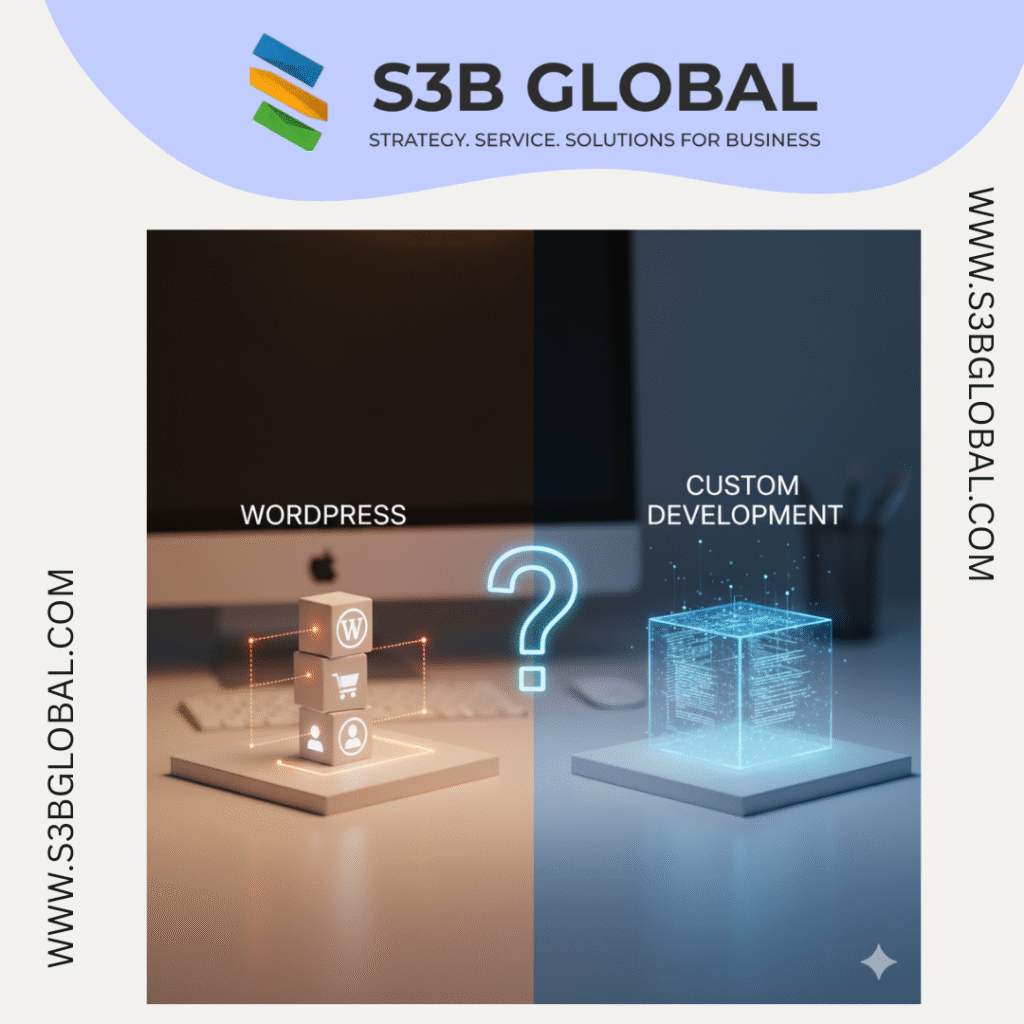
Choosing between WordPress and custom development is a common confusion for businesses building their online presence. Both approaches can produce excellent websites, but they differ in speed, cost, flexibility, maintenance, and long-term scalability. This post breaks down the trade-offs clearly so you can decide which path fits your goals, budget, and timeline.
Quick Summary
- Choose WordPress if you need speed, lower upfront cost, abundant plugins, and easier non-technical content management.
- Choose Custom Development if you need unique functionality, performance at scale, pixel-perfect design, or proprietary integrations that off-the-shelf solutions can’t deliver.
What WordPress Offers?
WordPress powers a large share of the web because it balances power and accessibility:
- Fast to launch: Pre-built themes and page builders let you move from concept to publish quickly.
- Cost-effective: Lower development hours for standard sites reduce initial cost.
- Huge ecosystem: Plugins exist for SEO, forms, e-commerce, caching, analytics and more.
- Content-first CMS: Non-technical editors can update pages, blog posts, and media without developer help.
- Large talent pool: Developers and agencies familiar with WordPress are widely available.
Limitations: Plugin conflicts, occasional performance issues on large sites, and security risks if not regularly updated or configured correctly.
What Custom Development delivers?
Custom (from-scratch) development is building the site specifically for your needs—no template compromises:
- Complete flexibility: Any user flow, integration, or visual treatment is possible.
- Optimized performance: Tailored code and architecture reduce overhead and improve speed.
- Security control: You control dependencies and can harden the app specifically for your threat model.
- Scalability: Architected for expected traffic and feature growth (microservices, headless APIs, etc.).
- Unique IP: Proprietary features become part of your product differentiation.
Limitations: Higher upfront costs, longer time-to-market, and heavier reliance on developers for content updates and minor changes.
Decision Factors: How to choose?
- Project Scope & Complexity
WordPress → Simple brochure, blog, small e-commerce, or marketing landing pages
Custom → Complex apps, custom workflows, heavy integrations, or marketplaces.
- Budget & Timeline
WordPress → Tight budget or fast launch
Custom → Adequate budget for long-term product development
- Maintenance & Ownership
WordPress → Manage content in-house with minimal dev support
Custom → Full control over updates, dependencies, and architecture
- Performance & Security Needs
WordPress → Moderate traffic and standard security (with proper hardening)
Custom → High traffic, strict compliance, or advanced security needs
- Design and Brand Uniqueness
WordPress → Good fit if brand can adapt to theme-based design
Custom → Pixel-perfect, bespoke experiences
Hybrid approaches worth considering
You don’t have to pick strictly one side:
- Headless WordPress (WordPress as CMS + custom front-end) gives content-editing convenience with a custom presentation layer.
- Custom plugins or microservices extend WordPress where needed without full rebuild.
- Starter frameworks (e.g., Laravel + CMS or JAMstack with a CMS) offer a middle path for performance and content control.
Cost and Lifecycle Perspective
- Upfront cost: WordPress is lower.
- Ongoing cost: WordPress requires plugin and core updates, hosting, and occasional fixes. Custom systems may have higher maintenance developer costs but can be more efficient long-term when well-architected.
- Total cost of ownership: Consider expected feature roadmap, integrations, and scaling needs when comparing lifetime costs.
Checklist — Which option fits you?
- Need a marketing website in 2–8 weeks with limited budget →
- Expect complex integrations, unique user flows, or heavy traffic in 12–24 months → Custom.
- Need editorial autonomy for non-technical teams → WordPress or headless CMS.
- Prioritize maximum performance and security customization → Custom.
Final recommendation
If your immediate goal is a content-rich marketing presence, rapid launch, or lower budget, start with WordPress—properly optimized and secured. If your long-term plan includes productizing web features, proprietary functionality, or servicing large-scale traffic, invest in custom development or a hybrid architecture that gives you editorial convenience and engineering control.
At S3B Global, we help teams choose the right approach and implement practical hybrids: fast WordPress launches with performance best practices, or purpose-built custom platforms designed for scale. If you’d like, we can assess your project briefly and recommend a roadmap with cost and timeline estimates.
Send us your project goals and we’ll provide a short roadmap (no obligation) to help you decide between WordPress, custom development, or a hybrid solution.
Email: info@s3bglobal.com
To know our Company . S3B Global
